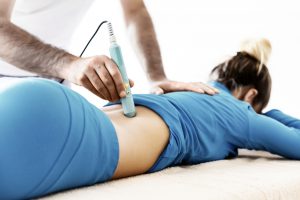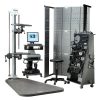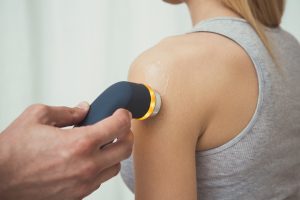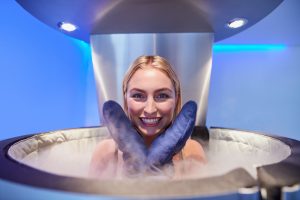
Cold Laser Therapy in Rehab
Treatment GuidelinesCold laser therapy works by targeting the tissue with specific wavelengths of light. The light emitted from the machine triggers biochemical changes within cells and promotes healing.
What is Cold Laser Therapy?
Cold laser therapy is also known as Low-level Laser Therapy (LLLT), Low-power Laser Therapy (LPLT), and Photobiomodulation Therapy (PBMT). This treatment has been used for over forty years to decrease pain and edema and heal muscles and bones.
It works by targeting the tissue with specific wavelengths of light. The light emitted from the machine triggers biochemical changes within cells and promotes healing. It also helps to eliminate pain and swelling. Cold laser therapy can treat patients who suffer from a variety of both acute and chronic conditions.
Because it can stimulate all cell types, cold laser therapy can treat several conditions. For example, it can treat arthritis, back pain, carpal tunnel syndrome, fibromyalgia, tendonitis, and general joint / muscle pain. In addition, several clinical studies (listed below) have given clinicians confidence in its use for individuals suffering from various types of pain 1.
Pain management can be one of the most challenging obstacles for clinicians. Traditional pain management through medicinal or more invasive means can be costly and poses risks. It provides many benefits in treatment with few contraindications or potential hazards 2.
How Does It Work?
Cold laser therapy involves low-intensity laser treatment that stimulates healing through light energy. As the light energy beams onto the affected area, the photons penetrate deep into the tissue and are absorbed. These photons cause changes in the tissue, which trigger healing responses on a cellular level. In other forms of laser treatment, much higher density forms of light are used to affect tissue, causing heat as a byproduct. The very low levels of light involved create the reaction without heating the tissue.
Through the diode of the machine, red or near-infrared light is beamed into the affected area. The energy absorbed stimulates changes within the cells. The cells absorb the light energy, which kickstarts a healing process. As different wavelengths of light reach the tissue, the cells react in various ways.
In addition to engaging the healing process, some data suggests that this treatment stimulates chemical changes3. According to the research, cells seem to release various hormones, including endorphins, which reduce pain. The treatment can also inhibit prostaglandins and other neurochemicals 3. While some pain management techniques only mask the symptoms, cold laser therapy addresses the underlying concern.
What Types of Conditions Can It Treat?
Cold laser therapy is used widely among rehab and training professionals. This treatment technique can address chronic pain as well as injury and swelling. Inflammation, wound care, joint pain, and chronic pain diagnoses can all benefit from this treatment. Here are some common diagnoses that can benefit:
- Arthritis
- Sprains
- Strains
- Overuse injuries such as tennis elbow or carpal tunnel
- Back pain
- Knee pain
- Bursitis
- Tendinitis
- Fibromyalgia
- Nerve pain
- Sports injuries
- Wound healing
- Stroke
- Skin healing
- Dental pain
There is no limit or regulation on the types of cells cold laser therapy can stimulate. As a result, any acute or chronic injury is treatable. Within even hours, cold laser therapy treatments can begin to show their benefit. As the cells activate their own healing processes, days and weeks from the treatment, patients experience reduced pain and swelling. One review of clinical trials showed 820 patients experienced relief immediately after treatment2. The same review found that up to 22 weeks from treatment, patients with chronic neck pain continued to experience benefits.
Why Is It So Effective?
Cold laser therapy provides an alternative to typical medical management of chronic and acute pain. Rather than risking adverse side effects of medications or invasive surgery, cold laser therapy risks are minimal. The treatment stimulates the body’s natural healing processes. There are almost no side effects reported. As patients become their own advocates, finding alternative treatment methods with minimal adverse reactions becomes more and more critical.
Cold laser therapy is not limited to pain relief. Some studies have shown that it could also trigger tissue growth or increase blood flow to the affected areas 1. As the cells heal, they release chemicals like endorphins, which limit pain. By kickstarting the healing process, it may have more far-reaching impacts on the immune system. And research 3 shows that it decreases sensitivity in injured areas, which increases the patient’s tolerance of other therapeutic techniques in treatment.
How Can You Use It in Your Practice?
Like any other treatment, training is readily available for clinicians. Numerous courses, both in-person and online, offer training and certification. These typically also serve as continuing education credits for your respective licenses. Since it is FDA-approved as a pain management modality, cold laser therapy is an appealing treatment alternative for your patients.
Typically, a treatment session only takes about 10 minutes. Once a provider makes the various adjustments, they hold the diode over the affected tissue, similar to ultrasound therapy. Generally, there are no immediate discernible effects, as the machine causes no heat or vibration. Treatments tend to be administered one to four times a week as a series of treatments to bring the most significant benefits. Somewhere between eight and 30 treatments, patients will usually see the most relief.
Although Medicare and Medicaid do not cover this form of treatment, some major insurance companies will. By adding cold laser therapy to your toolbelt as a clinician, you give your patients one more option for recovery and relief.
Sydney Moninger, COTA/L is an Occupational Therapy Assistant and freelance writer. She has more than 10 years of clinical experience working in pediatric, orthopedic, and geriatric settings. Most recently, she has been helping patients at a pain management center for orthopedic injuries. Sydney is passionate about patient education and increasing health literacy in the community, which is what got her started in her writing in the first place. She loves discovering new perspectives that improve her clinical practice, and connecting with others on LinkedIn or her Upwork page.
References:
- Cotler, H., et al. “The Use of Low-Level Laser Therapy (LLLT) for Musculoskeletal Pain”. NCBI. 2015. https://www.ncbi.nlm.nih.gov/pmc/articles/PMC4743666/
- Chung, H., et al. “The Nuts and Bolts of Low-level Laser (Light) Therapy”. NCBI. 2011. https://www.ncbi.nlm.nih.gov/pmc/articles/PMC3288797/
- Kingsley, J. D., et al. “Low-level laser therapy as a treatment for chronic pain”. NCBI. 2014. https://www.ncbi.nlm.nih.gov/pmc/articles/PMC4137223/
- Bernstein, S. “Cold Laser Therapy for Knee Pain”. WebMD. 2020. https://www.webmd.com/pain-management/knee-pain/cold-laser-knee-pain#1-3
- Dima, R, et al. “Review of Literature on Low-Level Laser Therapy Benefits for Non-Pharmacological Pain Control in Chronic Pain and Osteoarthritis”. PubMed. 2018. https://pubmed.ncbi.nlm.nih.gov/28987080/
- Musstaff, R., et al. “Assessing the impact of low level laser therapy (LLLT) on biological systems: a review”. PubMed. 2019. https://pubmed.ncbi.nlm.nih.gov/30614743/
- Pietrangelo, A. “Is Cold Laser Therapy Right for You?”. Healthline. 2019. https://www.healthline.com/health/laser-therapy#benefits
- Schnee, A. “Cold Laser Therapy Advantages and Disadvantages”. Veritas Health. 2009. https://www.spine-health.com/treatment/pain-management/cold-laser-therapy-advantages-and-disadvantages
- Schnee, A. “Types of Conditions Treated by Cold Lasers”. Veritas Health. 2009. https://www.spine-health.com/treatment/pain-management/types-conditions-treated-cold-lasers






